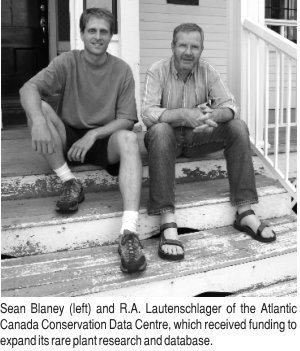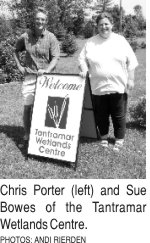
Editor's Notes
Smart funding from
old cans
Printer
Friendly Page
By Andi Rierden
YOU MIGHT CALL Sackville, New Brunswick the wetland conservation hub of the Canadian Maritimes. For a
start, the town is located on the edge of a huge wetland known as the Tantramar Marsh, one of North
America's major migratory bird routes. Occupying a vast expanse on the southern part of the Isthmus
of Chignecto where the grassy terrain meets the sediment-loaded waters of the Bay of Fundy, the
marsh's name is derived from the French word “tintamarre,” meaning racket or hubbub, a term the
Acadians used to describe the sound of the great flocks of waterfowl that visit this area. Add to
that a beautifully designed, 55-acre waterfowl park in the heart of Sackville and another 45 acres
of restored wetland habitat nearby and it's clear why the area draws throngs of nature tourists and
has received numerous national awards for its environmental accomplishments.
Sackville is not the only area to benefit. Altogether, almost $5 million in funding for
environmental projects will be handed out province-wide this year, through a noteworthy government
program.
Here's how it works: For every redeemable can or bottle returned, New Brunswickers receive half
of the full deposit of ten cents. Half of the remaining nickle is used by the beverage industry to
help pay for the cost of the recycling process. The rest goes to the Environmental Trust Fund (ETF),
managed by the Department of Environment and Local Government (DELG).
The program began in 1991 and has consistently raised around $5 million annually over the past
few years, said Dave Schellenberg, DELG's executive director of Corporate Services and Programs and
the coordinator of the ETF. This year, 193 projects - spanning the gamut of environment-related
issues from conservation to education, protection, restoration, sustainable development and
beautification - were chosen to receive funding. Schellenberg added that each application goes
through a rigorous review process and that the progress of each project chosen is monitored
throughout the year. “We're looking for action-oriented projects that will have a direct and
tangible benefit to the environment,” he said.
The Tantramar Wetlands Centre, which has received ETF funds since its inception in the late 90s,
certainly fits that bill. The centre began when a retired biologist with the Canadian Wildlife
Service started campaigning to have a stretch of abandoned farmland behind Tantramar Regional
High School restored to a marsh. In 1997 Ducks Unlimited Canada took on the task and constructed
a wetland, to be used solely for educational purposes. “Once we had a wetland we just started
building the program,” said Chris Porter, a science teacher at the high school and project director
of the wetlands centre.
Today the site consists of
45 acres of productive wildlife habitat, connected by a network of trails
and pathways to an on-site interpretive centre. Dotted with dozens of
swallow boxes and well-placed islands for nesting waterfowl, the marsh
provides quality habitat for thousands of plant and animal species, and
functions as a “rubber boots” learning experience for more than 4,000
school children that visit the centre each year. Sue Bowes, a wildlife
biologist, had volunteered at the wetlands centre for six years. Recently,
thanks to the ETF financing, the centre was able to hire her full-time.
In addition to school programs, staff and volunteers conduct teacher workshops,
evening birding courses and waterfowl banding instruction. Bowes said
the mission is to teach the importance of biodiversity and educate the
public to understand and respect the workings of an ecological system.
“We really drive home the message that wetlands are valuable places,” she said.
Rare plant detectives
Down the road from the wetlands centre, situated in the Presidents Cottage of Mount Allison
University, Dr. R.A. Lautenschlager and a staff of field botanists and zoologists are tracking
the status of thousands of species that have been ranked extremely rare to uncommon in New Brunswick,
Nova Scotia, Newfoundland, Labrador and Prince Edward Island. The information collected here at the
Atlantic Canada Conservation Data Centre and the staff's expertise about the region's biodiversity is
invaluable to researchers, educators and decision-makers or anyone looking to find data on the
abundance, for example, of a particular fern, orchid or sedge, or about the ecological communities
in which they occur.
One of the centre's projects involves mapping rare or uncommon plants that likely occur on
properties held by federal agencies. “Federal landowners are expected to know what's on their
property and what cannot be destroyed,” Lautenschlager said. The centre works closely with COSEWIC,
the federal committee that recommends listing a plant or animal as a species at risk and with groups
or agencies involved in protecting sensitive lands. The money the centre will receive this year from
ETF will go towards helping conserve two globally rare coastal plant species, the Gulf of St.
Lawrence beach pinweed and the Parker's pipewort, as well as developing an online guide to New
Brunswick forest ecosystems and improving the massive rare plant database. The ETF, said Sean Blaney,
a botanist and assistant director of the centre, “allows us to fund self-directed work where we
think the greatest information gain will be.”
Tantramar educators
The evolution of a marsh is “written” in the sediments, ecologists say. On the Tantramar Marsh,
sediments deposited since the end of the last glacial period are up to 30 meters [98 feet] thick.
Within these remnants a 4,500 year forest, with trunks up to a meter in diameter, are visible just
north of Fort Beausejour. While most of the marsh has been dyked and continues to be used largely
for agricultural purposes, the glacial, natural and human history of the marsh and overall watershed
has become a major part of the region's heritage.
Connop said he would also like to develop an ecological bus tour of the watershed, “Not from a
tourism point of view but for the community. I'd like to color it in such a way that it reflects the
dynamics of the river system and relate the geography and history of the region to the people who
live here.”
Other ETF funding that will go to projects in the Bay of Fundy region include a long-term water
quality monitoring program to be put in place by the Petitcodiac Watershed Monitoring Group, a study
by Mount Allison University, in partnership with Ducks Unlimited, to determine how the large bird
community reacts to the restoration of salt marsh in the Musquash Marsh system near Saint John, and
a project by the New Brunswick Nature Trust to complete the protection of Sam Orr's Pond near St.
Andrews, which contains a unique brackish water pond and is home to several rare plants.
Schellenberg of DELG is advising potential applicants to check the department's Web site in late
fall for an announcement of timelines and deadlines for the next round of ETF financing. That address
is: www.gnb.ca/0009.
©
2005 The Gulf of Maine Times
 It is no surprise either that nearly $260,000 will be going to the Sackville region this year - thanks
to recycled beverage cans and bottles - to help local non-profit groups carry out a host of
wetland-related initiatives.
It is no surprise either that nearly $260,000 will be going to the Sackville region this year - thanks
to recycled beverage cans and bottles - to help local non-profit groups carry out a host of
wetland-related initiatives.
 Engaging local residents in the stewardship of the watershed is one of the Tantramar Watershed
Committee's missions. The committee received $45,000 to develop education and interpretive programs
aimed to bring the many aspects of the Tantramar together. Committee Coordinator James Connop plans
to use the funds to make a documentary of the conservation activities taking place in the watershed,
which covers a 300-square-kilometer [116-square-mile] drainage basin for the Tantramar and Aulac
Rivers.
Engaging local residents in the stewardship of the watershed is one of the Tantramar Watershed
Committee's missions. The committee received $45,000 to develop education and interpretive programs
aimed to bring the many aspects of the Tantramar together. Committee Coordinator James Connop plans
to use the funds to make a documentary of the conservation activities taking place in the watershed,
which covers a 300-square-kilometer [116-square-mile] drainage basin for the Tantramar and Aulac
Rivers.